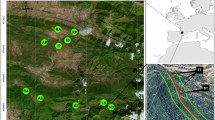Summary
-
(1)
The experimental forest at Brookhaven National Laboratory, Long Island, subject to chronic gamma irradiation since 1961, was resurveyed in July 1976. A grid of 2400 plots covering an area centered at the radiation source and 50 m in radius was supplemented by five transects extending 50 to 100 m from the source.
-
(2)
Data were analyzed by ordination, estimation of alpha and beta diversity, species contagion, and sample heterogeneity; different techniques for each of these were compared for effectiveness.
-
(3)
Ordinations indicated a gradient from a less damaged tree and shrub community through a shrub zone and sedge-herb meadow to radiation-resistant herbs and lichens. The radiation-resistant species spread as the communities adapted to radiation stress.
-
(4)
Total plant alpha diversity declined toward the radiation source, but herb alpha diversity was highest at intermediate irradiation. Beta diversity, as compositional change along the radiation gradient, was high (2.7 half-changes); most rapid compositional change occurred near the radiation source.
-
(5)
Contagion of individual species increased toward the source, and samples were most heterogeneous near the source.
-
(6)
Perennial old-field herbs have become predominant near the radiation source since earlier surveys; current trends suggests development toward a more stable community-gradient in response to stress.
09
Similar content being viewed by others
References
Bratton, S.P. 1975. A comparison of the beta diversity functions of the overstory and herbaceous understory of a deciduous forest. Bull. Torr. Bot. Club 102: 55–60.
Bray, J.R. & J.T. Curtis. 1957. An ordination of the upland forest communities of southern Wisconsin. Ecol. Monogr. 27: 325–249.
Cottam, G., F.G. Goff & R.H. Whittaker. 1973. Wisconsin comparative ordination. In: Ordination and Classification of Communities, ed. R.H. Whittaker. Handb. Veget. Sci. 5: 193–222. Junk, The Hague.
Dyksterhuis, E.J. 1949, Condition and management of range land based on quantitative ecology. J. Range Manage. 2: 104–115.
Fernald, M.L. 1950. Gray's Manual of Botany, 8th ed. D. Van Nostrand Co., New York.
Flaccus, E., T.V. Armentano & M. Archer. 1974. Effects of chronic gamma radiation on the composition of the herb community of an oak-pine forest. Radiation Bot. 14: 263–271.
Gauch, H.G. 1973. The relationship between sample similarity and ecological distance. Ecology 54: 618–621.
Greig-Smith, P. 1964. Quantitative Plant Ecology, 2nd ed. Butterworth, London.
Hill, M.O. 1973a. The intensity of spatial pattern in plant communities. J. Ecol. 61: 225–236.
Hill, M.O. 1973b. Reciprocal averaging: an eigenvector method of ordination. J. Ecol. 61: 237–249.
Maarel, E. van der 1976. On the establishment of plant community boundaries. Ber. Deutsch. Bot. Ges. 89: 415–443.
Olsvig, L.S., J.F. Cryan, & R.H. Whittaker. 1979. Vegetational gradients of the Pine Plains and Barrens of Long Island, New York. In: Richard T.T. Forman (ed.) Pine Barrens: Ecosystem and Landscape, pp. 265–282. Academic Press, New York.
Oosting, H.J. 1956. The Study of Plant Communities. Freeman, San Francisco.
Snedecor, G.W. & W.G. Cochran. 1967. Statistical Methods. Iowa State Univ., Ames, Iowa.
Wagner, R.H. 1966. Herbaceous recolonization of the Brookhaven irradiated forest: the first three years. Radiation Bot. 6: 561–566.
Westman, W.E. 1971. Production, nutrient circulation, and vegetation-soil relations of the pygmy forest region of northern California. Ph. D. thesis, Cornell Univ., Ithaca, New York. 411 pp.
Whittaker, R.H. 1960. Vegetation of the Siskiyou Mountains, Oregon and California. Ecol. Monogr. 30: 279–338.
Whittaker, R.H. 1967. Gradient analysis of vegetation. Biol. Rev. 42: 207–264.
Whittaker, R.H. 1972. Evolution and measurement of species diversity. Taxon 21: 213–251.
Whittaker, R.H. 1977. Evolution of species diversity in land communities. Evol. Biol. 10: 1–67.
Whittaker, R.H. & W.A. Niering. 1965. Vegetation of the Santa Catalina Mountains (II). A gradient analysis of the south slope. Ecology 46: 529–542.
Whittaker, R.H. & G.M. Woodwell. 1969. Structure, production and diversity of the oak-pine forest at Brookhaven, New York. J. Ecol. 57: 157–174.
Whittaker, R.H. & G.M. Woodweil. 1973. Retrogression and coenocline distance. In: Ordination and Classification of Communities, ed. R.H. Whittaker. Handb. Veget. Sci. 5: 53–74. Junk, The Hague.
Woodwell, G.M. 1962. Effects of ionizing radiation on terrestrial ecosystems. Science 138: 572–577.
Woodwell, G.M. 1967. Radiation and the patterns of nature, Science 156: 461–470.
Woodwell, G.M. & T.P. Gannutz, 1967. Effect of chronic gamma irradiation on lichen communities of a forest. Amer. J. Bot. 54: 1210–1215.
Woodwell, G.M. & E.C. Hammond, 1962. A descriptive technique for study of the effects of chronic ionizing radiation on a forest ecological system. BNL 715 (T-251). Brookhaven National Laboratory, Upton, Long Island.
Woodwell, G.M. & A.L. Rebuck. 1967. Effects of chronic gamma radiation on structure and diversity of an oak-pine forest. Ecol. Monogr. 37: 53–69.
Woodwell, G.M. & R.H. Whittaker, 1968. Effects of chronic gamma irradiation on plant communities. Quart. Rev. Biol. 43: 42–55.
Author information
Authors and Affiliations
Additional information
Plant names follow Fernald (1950).
I thank the staff at Brookhaven National Laboratory for help and facilities while conducting field work for this study; and Hugh G. Gauch, Jr., Steve Sabo, R. H. Whittaker, and G. M. Woodwell for suggestions, review, and advice. This article is dedicated to the memory of Arnold Sparrow, who initially sponsored this project.
Rights and permissions
About this article
Cite this article
Olsvig, L.S. Pattern and diversity analysis of the irradiated oak-pine forest, Brookhaven, New York. Vegetatio 40, 65–78 (1979). https://doi.org/10.1007/BF00055836
Accepted:
Issue Date:
DOI: https://doi.org/10.1007/BF00055836



